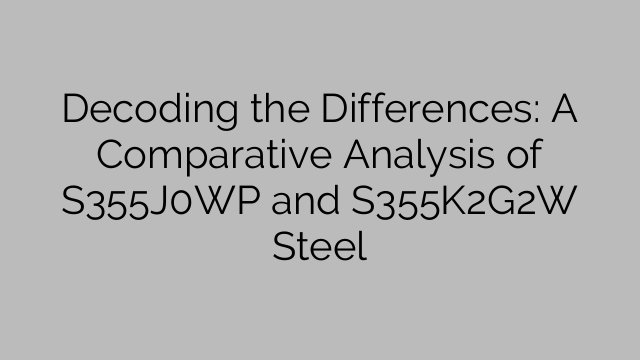Decoding the Differences: A Comparative Analysis of S355J0WP and S355K2G2W Steel
Steel is a versatile and widely-used material in construction, manufacturing, and various other industries. It is valued for its strength, durability, and resistance to environmental factors. However, not all steels are the same, and understanding the differences between different types of steel is crucial for making informed decisions on material selection. In this article, we will delve into the comparative analysis of two weathering steels – S355J0WP and S355K2G2W – and decode their differences.
1. Composition:
a) S355J0WP: S355J0WP is a structural steel grade with a minimum yield strength of 355 N/mm². It contains a variety of alloying elements such as chromium, copper, nickel, and phosphorus to enhance its corrosion resistance properties. The presence of these elements forms a protective oxide layer on the steel surface, preventing further corrosion.
b) S355K2G2W: S355K2G2W is also a structural steel grade with a minimum yield strength of 355 N/mm². However, it contains additional alloying elements such as vanadium and titanium, which enhance its weathering resistance and provide better mechanical properties compared to S355J0WP.
2. Weathering Properties:
a) S355J0WP: S355J0WP steel is specifically designed for applications where exposure to weather conditions is a significant factor. Its weathering properties allow the steel to develop a protective, self-adhesive patina layer when exposed to the atmosphere. This patina layer acts as a barrier against further corrosion and reduces the need for maintenance, making it suitable for outdoor structures.
b) S355K2G2W: S355K2G2W steel, with its additional alloying elements, offers even better weathering properties compared to S355J0WP. It forms a more dense and stable patina layer, providing enhanced protection against atmospheric corrosion. This makes it a preferred choice for structures subjected to harsh weather conditions or industrial environments.
3. Mechanical Properties:
a) S355J0WP: The mechanical properties of S355J0WP steel include a minimum yield strength of 355 N/mm² and a minimum tensile strength of 490-630 N/mm². These properties ensure its structural integrity and load-bearing capacity, making it suitable for various construction applications.
b) S355K2G2W: S355K2G2W steel exhibits higher mechanical strength than S355J0WP, with a minimum yield strength of 355 N/mm² and a minimum tensile strength of 510-680 N/mm². This added strength allows for the construction of more robust and durable structures.
4. Applications:
a) S355J0WP: Due to its weathering properties, S355J0WP steel is commonly used in outdoor structures like bridges, buildings, and railway wagons. It eliminates the need for painting or protective coatings, reducing maintenance costs over time.
b) S355K2G2W: With its superior weathering resistance and mechanical properties, S355K2G2W steel finds application in more demanding environments, such as coastal areas with high salt exposure, chemical plants, and industrial facilities.
In conclusion, both S355J0WP and S355K2G2W are weathering steel grades designed to withstand atmospheric corrosion. While S355J0WP offers good weathering properties, S355K2G2W surpasses it in terms of enhanced corrosion resistance and mechanical strength. The choice between these two steels depends on the specific requirements of the application, environmental factors, and budget constraints. By understanding their composition, weathering properties, and mechanical strengths, project managers and engineers can make informed decisions and select the most appropriate steel for their projects.

